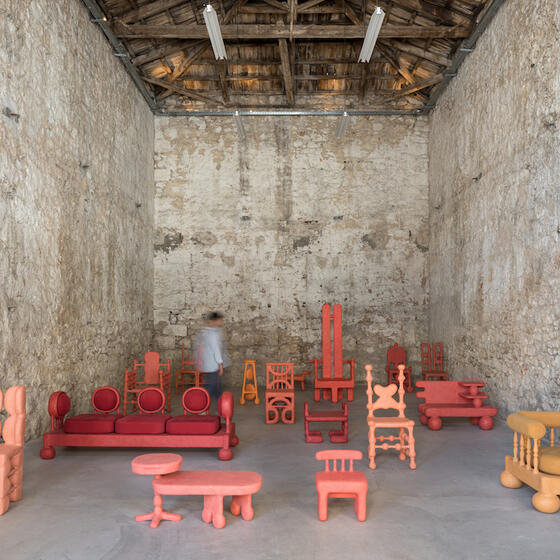In the San Isidro district of Old Havana, tough times have prompted an outpouring of street art. Imogen Lepere joins a local crew
10 October, 2022
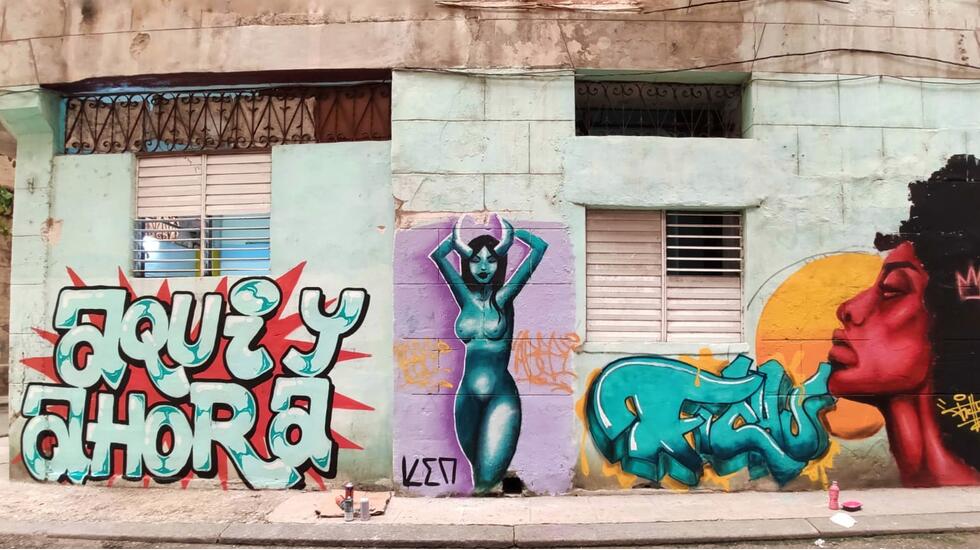
I
peer hopefully into the front-room shop, my mouth as dry as
the piles of grit that have blown in from the street to settle in
its corners. The old boys drinking rum from little plastic cups
turn to stare at me.
“Tiene agua?” I ask the owner, bolstering my poor Spanish with
the ubiquitous hand gesture of lifting a bottle. She shakes her
head.
“Solo ron (only rum).”
It’s the fifth shop I’ve tried. I shrug, take a litre of rum and
as many cigarettes as I can carry and head back into the sagging
streets of Old Havana.
Cuba is staggering under economic sanctions imposed by the
former administration of President Trump, as well as the effects of
an economic crisis triggered by Covid – the most devastating since
the fall of the Soviet Union in 1991. Although rum and cigarettes
are apparently the only things not in short supply (unlike drinking
water and flour), I’ve learnt it’s wise to stock up on whatever you
can whenever you get the chance.
In San Isidro – a tangle of streets in Old Havana with washing
strung between the balconies of houses so tired you wonder how
they’re still standing – tough times have coincided with an
outpouring of street art. I’m travelling through these streets with
Spanish graffiti writers Sin Prisas (Carlos Pérez) and Dabuten
Tronko (Joel Uve). They’ve come to paint with a local crew who call
themselves “the freaks”.
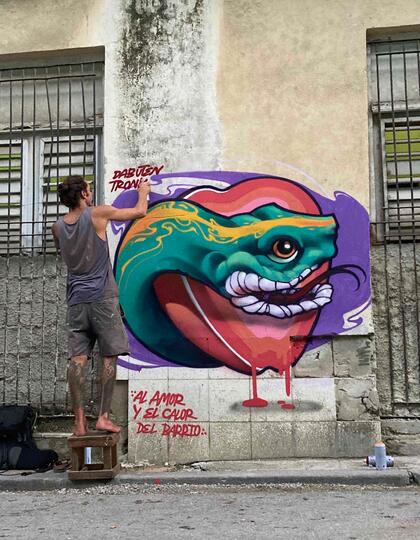
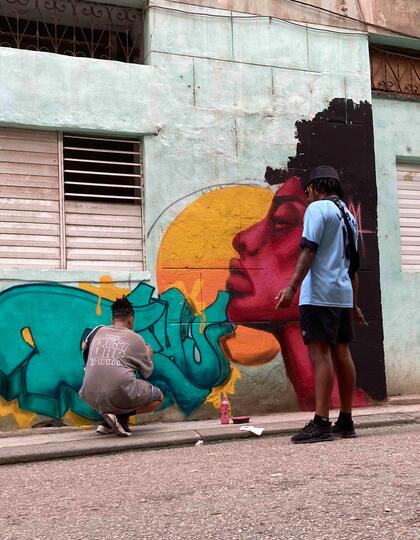
Working on street murals. | Photo credit:
@imogenleperewriter
“San Isidro is a marginalised neighbourhood that has become an
arts district,” says El Fichu (Dennys Alejandro Arroyo Suárez). He
started painting as a child, scribbling on his bedroom wall. “It
all kicked off when Galería Taller Gorría opened in an old factory
in 2016.”
“Look, you can see murals demonstrating every technique here:
spray, characters, realistic, lettering, templates and rollers,”
says Abepi (José Carlos Hernández Rizo), waving a heavily tattooed
arm casually at a row of houses. They look like a history lesson
spanning 500 years. “It’s a mixture of Cuban and international
names: 2+2=5, Mr Myl, Yulier P, Abstrak, Stephen Palladino, Paola
Delfin, Vikism, Entities, Atomik, Jose Mertz – they’ve all left
their mark.”
“Although street art began a long time ago on the island, it has
always been controversial as it’s so spontaneous and art is often
censored here,” El Fichu muses. “But in San Isidro, people are very
progressive. They’re used to living with art and welcome us into
their homes.”
Every kid in the barrio wants a fist pump and to sign their name beside the artists’ in wobbly letters
As if to prove the point, Abepi knocks on a door. A young woman
wiping her hands on a rag answers. She looks a little taken aback
but smiles and gestures to the front wall of her house.
Within minutes, all four artists are at work on different
sections. Unlike Sin Prisas and Dabuten Tronko, who start their
serpent design with a spray can and deft flicks of their wrists, El
Fichu and Abepi reach for their rollers.
“Spray painting is practically impossible in Cuba because they
don’t sell it here,” Abepi says. “We mostly use acrylics and
brushes. Because of the lack of resources, we try to make the most
of what materials we have.”
I sit on the pavement and crack open the rum. Someone cranks up
a sound system and reggaeton drowns out the man hawking tamales
from his handcart. Neighbours watch the murals come to life from
their balconies. Women bring buckets of washing out to the stoop.
Every kid in the barrio wants a fist pump and to sign their name
beside the artists’ in wobbly letters.
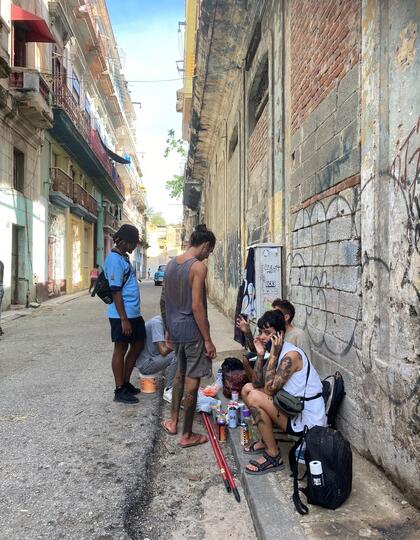
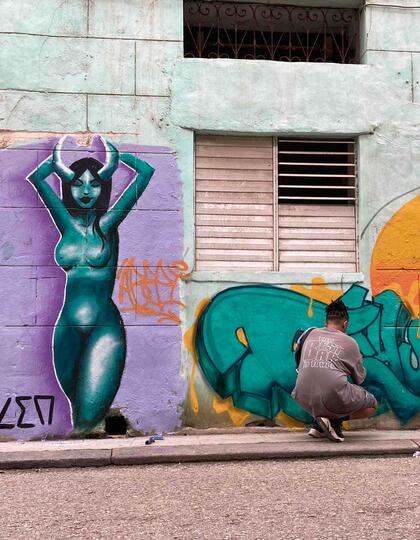
“The freaks” pause between works, left, and an artist adds
the finishing touches. | Photo credit: @imogenleperewriter
Later, El Fichu takes us home to the apartment he shares with
his mother and siblings. The outside of the building is slathered
in his signature curvaceous women with blanked-out eyes, but so,
too, are the communal halls and staircase. “I’ve never seen
graffiti inside like this,” whispers Sin Prisas.
As El Fichu’s mum cooks mince, rice and plantain, neighbours
wander in and out to see what’s on TV and take turns holding the
baby. I reflect that this merging of indoor and outdoor, public and
private space is what makes San Isidro so special. When your home
is a living, breathing art gallery, anyone can be an artist and
life itself becomes art.
Swerve Havana’s historic centre and head to San Isidro’s
Distrito de Arte – an open-air museum for urban
artists – where five or six paint-daubed blocks are putting the
humble neighbourhood on the international art map. Make pit stops
in galleries such as Galería Taller Gorría (214 San Isidro) and
refuel in the many cafés springing up to meet the growing visitor
numbers, between stopping to check out landmark pieces including
Green Girl by Abstrak and
Diamond by Mr Myl (both on San
Isidro), Guitarist by Stephen
Palladino (Jesús María 20), Devil Woman
by Abepi and Aquí y Ahora (Here
and Now) by Sin Prisas (both on Aguiar/Muralla and
Sol) and El Fichu’s Soul on Fire and
Dabuten Tronko’s Forbidden Fruit (both on
Valesco/Compostela and Habana).
Main photo credit: @sinprisass
